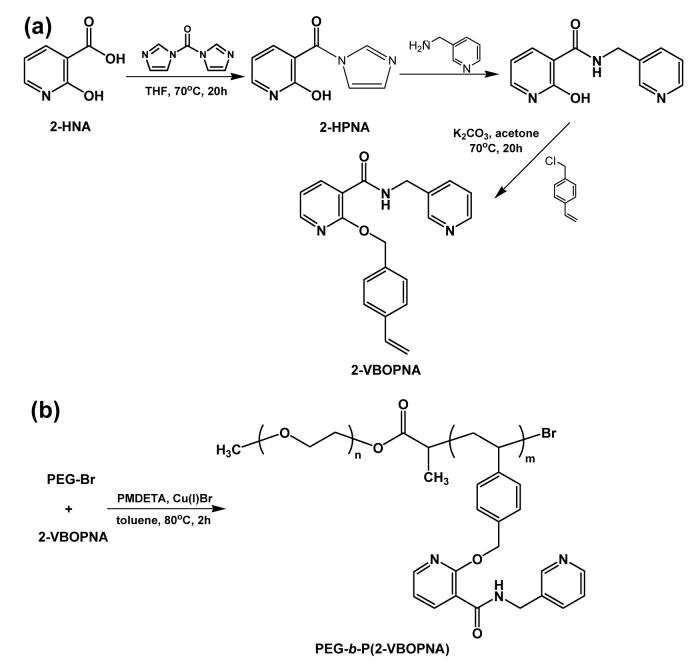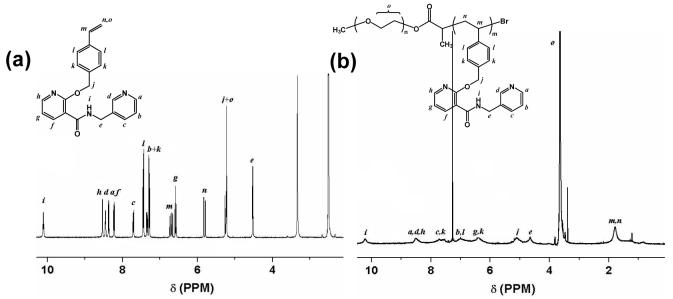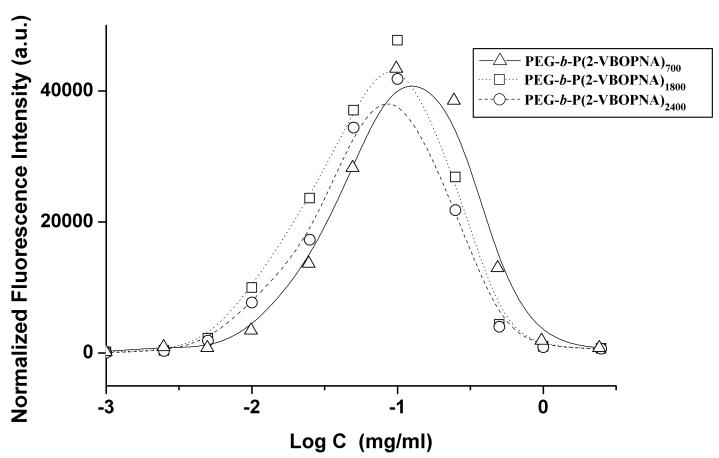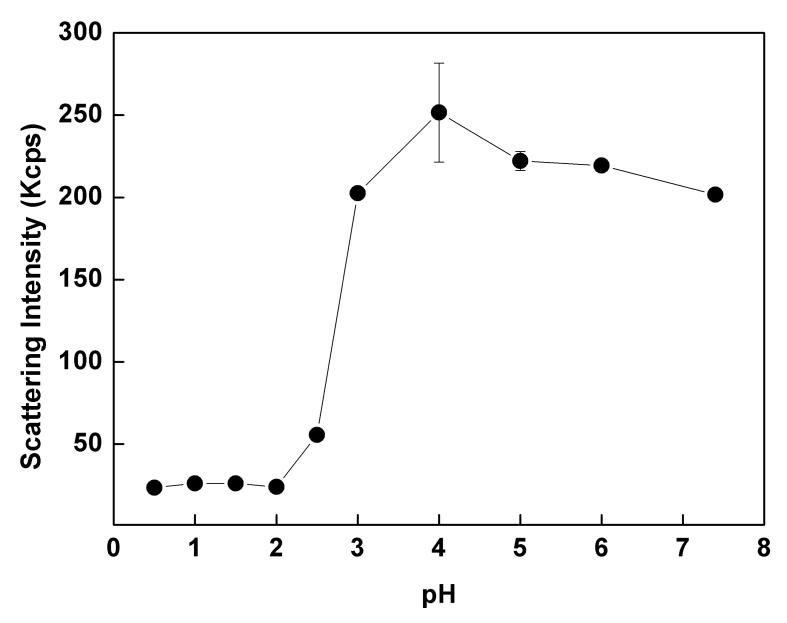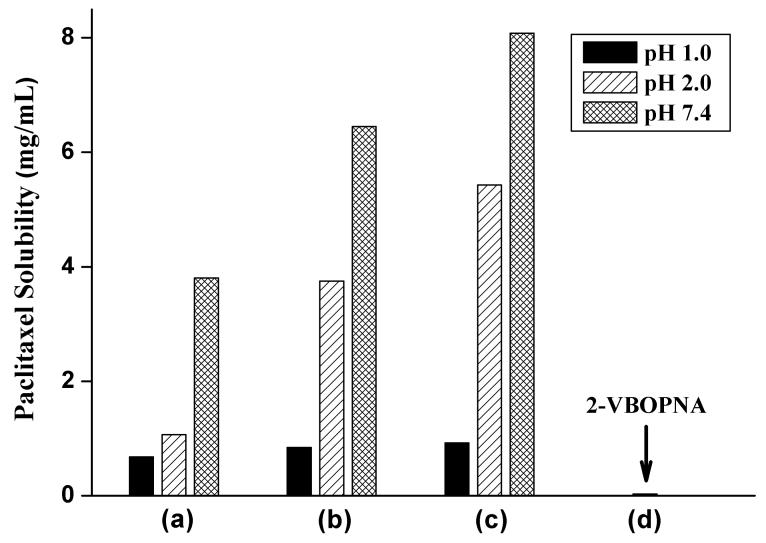Abstract
Paclitaxel (PTX), a potent anti-cancer drug, is poorly soluble in water, and this has been a major limitation in developing patient friendly formulations for clinical applications. Recent studies on polymeric micelles, especially hydrotropic polymer micelles, have suggested an alternative formulation of PTX based on their high loading capacity and physical stability in aqueous media. The present study aims at aqueous solubilization of PTX in polymer micelles without using any organic solvents that is usually required for solubilization in polymer micelles. Poly(ethylene glycol) was used as a hydrophilic block and, as a hydrotropic block, poly(4-(2-vinylbenzyloxy-N-picolylnicotinamide)) (P(2-VBOPNA)) was synthesized by atom transfer radical polymerization. The hydrotropic block copolymers did not form a micellar structure at pH 2 or below due to protonation of PNA groups, but the aqueous solubility of PTX increased significantly by the hydrotropic activity of P(2-VBOPNA). At pH values higher than 2, the PTX solubility increased even further due to deprotonation of 2-VBOPNA, leading to effective polymer micellization. A longer hydrotropic block resulted in higher aqueous PTX solubility, and slightly slower release rate from the micelles. The hydrotropic block copolymers synthesized in this study are able to form PTX-loaded polymeric micelles in aqueous solution without using any organic solvents.
Keywords: paclitaxel, hydrotropic block copolymer, picolylnicotinamide, micelle, aqueous solubility
1. Introduction
Poor water-solubility of therapeutic drugs has often caused significant problems during formulation for clinical applications [1]. Paclitaxel (PTX) is a well known anticancer agent that has provided effective treatment for a wide range of tumors, but it is also notorious for its poor water solubility [2]. A co-solvent system, Cremophor EL® (a polyoxyethylated caster oil)/ethanol (50:50, v/v), has been successfully used to solubilize PTX, but a large volume of solvent should be applied for completely dissolving the drug, which frequently causes life-threatening hypersensitivity [3, 4].
Although reduced amounts of Cremophor EL® were employed to formulate PTX, alternative methods have been designed and studied to enhance the water-solubility of PTX [5]. Polymeric micelles systems are one of these efforts [6-9]. Amphiphilic block copolymers spontaneously assemble in aqueous media to form a micelle structure above their critical micelle concentration (CMC), which consists of hydrophilic shell and hydrophobic core. Hydrophobic drugs can be loaded into the core and stabilized in an aqueous environment. In spite of good colloidal and drug-solubilizing properties, the low drug loading efficiency and use of organic solvents for drug loading are still significant concerns in the polymeric micelle formulations [10-12]. Thus, this study focuses on the solvent-free system for PTX loading based on a pH-dependent micellization [13-16] and hydrotropic effect for PTX solubilization in aqueous media [10, 17-19].
Hydrotropic agents are water-soluble compounds, which, at high concentrations, can enhance the water-solubility of very hydrophobic compounds [20-22]. Among these hydrotropic agents, N-picolylnicotinamide (PNA) has excellent capacity for PTX solubilization in water (29.44 mg/mL at 3.5M) [19]. In addition, it has pH-sensitivity due to protonation of pyridine residues in an acidic medium. In this study, several hydrotropic block copolymers consisting of a hydrophilic poly(ethylene glycol) (PEG) block and a hydrotropic polymer block were synthesized by the atom transfer radical polymerization (ATRP). An N-picolylnicotinamide (PNA) derivative having reactive vinyl group was used as a hydrotropic monomer as well as a pH-responsive moiety. The primary goal of the present study was to evaluate how effectively the hydrotropic block copolymers can solubilize PTX without aid of any organic solvent to generate PTX-loaded micelles. The PTX solubility as a function of the medium pH and polymer concentration was investigated, and the relationship between the PTX solubility and the properties of polymer micelles was studied.
2. Materials and Methods
2.1. Materials
Monomethoxy poly(ethylene glycol) (MPEG, Mn 5000) was purchased from Sigma-Aldrich Co. (St. Louis, MO, USA), which was purified before use by precipitation against excess diethyl ether and vacuum drying. Triethylamine (TEA), 2-bromopropionyl bromide (BPB), 2-hydroxy nicotinic acid (2-HNA), 1,1′-carbonyldiimidazole (CDI), 3-picolylamine, 4-vinylbenzyl chloride (VBC), 2-methyl-bromopropionate (MBP), copper(I) bromide (Cu(I)Br), potassium carbonate (K2CO3) toluene, and N,N,N’,N”,N”-pentamethyldiethylenetriamine (PMDETA) were also purchased from Sigma-Aldrich. All the liquids were dried and distilled before use. Paclitaxel (PTX) was kindly supplied from Samyang Genex Co. (Daejeon, Korea).
2.2. Synthesis of 2-(4-(vinylbenzyloxy)-N-picolylnicotinamide) (2-VBOPNA)
2-VBOPNA was synthesized by reaction of 2-hydroxy-N-picolylnicotinamide (2-HPNA) and VBC (Fig. 1a). 2-HPNA was prepared by the same method reported previously [19]. K2CO3 (30.16 g, 0.220 mol) and 2-HPNA (20 g, 0.088 mol) were suspended in dry acetone (600 mL) at 70°C, and then, VBC (26.64 g, 0.176 mol) was slowly dropped. After reaction for 20 h, the crude solution was filtered and product was isolated by silica gel column chromatography using tetrahydrofuran (THF)/n-hexane. Pure 2-VBOPNA was obtained from recrystallization in THF/n-hexane. Yield 75%. Anal. Calcd for C21H19N3O2: C, 73.03; H, 5.54; N, 12.17. Found: C, 73.19; H, 5.60; N, 12.13.
Figure 1.
Synthetic scheme of 2-(4-(vinylbezyloxy)-N-picolylnicotinamide) (2-VBOPNA, a) and PEG-b-P(2-VBOPNA) (b).
2.3. Synthesis of diblock copolymers of PEG and P(2-VBOPNA) (PEG-b-P(2-VBOPNA))
Brominated MPEG (PEG-Br) was prepared by the same method as reported elsewhere [10, 18]. A series of diblock copolymers of MPEG and P(2-VBOPNA) were synthesized by ATRP of 2-VBOPNA initiated from the PEG-Br (Fig. 1b). PEG-Br macroinitiator (0.4 g, 0.08 mmol), 2-VBOPNA (0.4 g, 1.16 mmol), and Cu(I)Br (0.046 g, 0.32 mmol) were added to a flame-dried round-bottom flak. The flask was evacuated and refilled with dry nitrogen twice. Toluene (2 mL) was degassed separately and added into the flask. After the mixture was stirred and purged with N2 for 10 min, PMDETA (0.054 g, 0.32 mmol) was introduced and the flask was placed in a preheated oil bath. During reaction at 80°C for 2 h, the increase in viscosity of the solution was observed. After polymerization, methylene chloride (15 mL) was added and the coppor catalyst was removed by a silica gel column. The block copolymers were repeatedly precipitated against diethyl ether. Further purification was performed by filtration (0.2 μm nylon filter) of block copolymers solution in warm water (50°C), in order to remove P(2-VBOPNA) homopolymer. Final product was obtained by freeze- and vacuum-drying. Diblock copolymers with different P(2-VBOPNA) blocks were synthesized as the same method by changing the monomer/initiator ratio. A homopolymer of P(2-VBOPNA) was polymerized from MBP. PEG-b-P(2-VBOPNA): Yield 75-80 %; 1H NMR (CDCl3): δ 0.83-1.57 (br, 3H), 2.10 (br, 6H), 3.34 (s, 3H), 3.36 (t, J = 5.0 Hz, 2H), 3.42-3.79 (m, 450H), 3.84 (t, J = 5.0Hz, 2H), 4. 62 (s, 6H), 5.13 (br s, 6H), 6.40 (br, 9H), 7.09 (br, 9H), 7.52 (br, 3H), 7.69 (br, 3H), 8.51 (br, 9H), 10.19 (br, 3H).
2.4. Characterizations of diblock copolymers of PEG-b-P(2-VBOPNA)
Molecular weight and molecular distribution were obtained from GPC (Agilent 1100 series RI detector, quaternary pump, Santa Clara, CA, USA) using a set of two PLgel 5 μm MIXED-D & E columns (Agilent). THF was used as an eluent and the flow rate was 1mL/min at 35°C. Chromatograms were analyzed based on a PEG standard curve. The chemical compositions of diblock copolymers were confirmed from 1H-NMR (JNM-AL400 FT-NMR spectrometer, 400MHz, JEOL Ltd., Tokyo, Japan).
2.5. Light scattering study
Dynamic light scattering measurement was performed at 25 °C using Brookhaven BI-200SM goniometer and BI-9000AT autocorrelator (Brookhaven Instrument Corp., Holtsville, NY, USA). Sample solutions were prepared by dissolving lyophilized power into deionized water (0.5 mg/mL) followed by brief sonication and filtration through a 0.45 μm syringe filter. The scattered light of a vertically polarized He-Ne laser (633 nm) was measured at the angle of 90° and was collected by the autocorrelator. The hydrodynamic diameters (d) of micelles were calculated by using the Stokes-Einstein equation d = kBT/3πηD, where kB is the Boltzmann constant, T is the absolute temperature, η is the solvent viscosity, and D is the diffusion coefficient.
2.6. Fluorospectrometry
Fluorescence spectra of PEG-b-P(2-VBOPNA)s were obtained using JASCO FP-6500 fluorospectrometer (Great Dunmow, Essex, UK) at room temperature. Sample solutions were prepared by dissolving polymer powder in double-distilled water (2.5 mg/mL). By serial dilution, concentration of polymer solutions was ranged from 2.5×10-5 to 2.5 mg/mL. All samples were degassed by gentle bubbling of nitrogen for 30 min before measurements. At 330 nm excitation light (slit 2.0 nm), emission spectra were monitored at 380 nm (slit 1.0 nm) and accumulated with an integration of 3 s/nm.
2.7. Solubility test
Excess amount of PTX was added to screw-capped vials containing 1 mL of polymer solutions in phosphate buffered saline (0-10%, w/v). The samples were incubated in a shaking water bath (90 rpm, 37°C) for 24 h. Each solution was quickly filtered through pre-warmed syringe filter (0.2 μm) and analyzed by reverse phase (RP)-HPLC system (Futecs NS-6000A, Daejeon, Korea) using a C18 column (ProntoSIL Co., Chadds Ford, PA, USA). The mobile phase was acetonitrile/water (45:55) mixture and the flow rate was 1.0 mL/min. Solubility values were determined by a calibration curve of various PTX concentrations (0.1-100 μg/mL) versus integrated area (mAU·s), which was monitored at 227 nm.
2.8. Transmission electron microscopy
Sample solution (10 mg/mL) was dropped onto a 400-mesh copper grid coated with carbon. After a minute, the grid was trapped with a filter paper to remove water and dried again. Then, 5% (w/v) of uranyl acetate solution was dropped to the grid. Excess solution was removed and the sample was dried under atmosphere. Transmission electron microscopy (TEM) images were obtained using JEOL JEM-2000EX (Tokyo, Japan), operating at the acceleration voltage of 200 kV.
2.9. PTX release from polymer micelles
In vitro release of PTX from PEG-b-P(2-VBOPNA) micelles was conducted using 0.8 M sodium salicylate solution (pH∼6.0) as a sink medium [17]. The concentration of PTX was 0.25 mg/mL. Polymer micelles loading the same amount of PTX (0.25 mg) were placed into dialysis membrane bag (MWCO 6000-8000 Da). The whole bag was sunk in 40 mL of sodium salicylate solution (37°C). The medium was refreshed at a given time and taken media was stored in refrigerator till HPLC analysis.
3. Results and discussion
3.1. Synthesis of block copolymers of PEG-b-P(2-VBOPNA)
Several hydrotropes for PTX solubilization in water were identified in our previous study [11]. Two excellent hydrotropic agents were N-picolylnicotinamide (PNA) and N,N-diethylnicotinamide (DENA) which increased the aqueous PTX solubility up to 29.44 and 39.07 mg/mL, respectively, at the 3.5 M concentration. When the PNA homopolymer was synthesized, it enhanced the aqueous PTX solubility by more than 103 times to 0.56 mg/mL. Such an excellent hydrotropic effect, however, was available only at pH 2 or below due to the pH-dependent polymer solubility in the aqueous media [19]. In this study, PEG-based diblock copolymers containing the PNA moieties were synthesized to prepare polymer micelles that increase the PTX solubility independent of the medium pH.
Various polymers were synthesized by ATRP method, which allowed good controllability of the polymer molecular weight [10, 18]. The high purity of brominated MPEG (Mn 5000, PEG-Br), the initiator, was confirmed by 1H- and 13C-NMR. In the 13C-NMR, a diagnostic methylene signal at δ 61.9 ppm (CH3O-PEG-CH2-OH) completely disappeared after bromination process. A hydrotropic monomer, 2-(4-(vinylbenzyloxy)-N-picolylnicotinamide) (2-VBOPNA), showed well-defined 1H-NMR spectrum without any impurity peaks (Fig. 2a). Molecular weights of three PEG-b-P(2-VBOPNA)s with different block ratios are listed in Table 1. In the 1H-NMR analysis, the ethylene proton ratio of PEG (O-CH2CH2-) and VBOPNA backbone (-CH2CH-) was used to calculate the molecular weight (Fig. 2b). GPC analysis revealed that all diblock copolymers had very narrow range of polydispersity (1.01-1.02), which is the best advantage of the ATRP method [23].
Figure 2.
1H-NMR spectra of 2-VBOPNA (a, DMSO-d6) and PEG5000-b-P(2-VBOPNA)2400 (b, CDCl3).
Table 1. Characterization of PEG5000-b-P(2-VBOPNA)s.
| Polymer | Mna) (g/mol) | Mnb) (g/mol) | Mw/Mnb) | CMCc) (mg/mL) |
|---|---|---|---|---|
| PEG5000-b-P(2-VBOPNA)700 | 5700 | 7400 | 1.008 | 0.1285 |
| PEG5000-b-P(2-VBOPNA)1800 | 6800 | 7600 | 1.012 | 0.0905 |
| PEG5000-b-P(2-VBOPNA)2400 | 7400 | 8950 | 1.016 | 0.0855 |
Calculated from peak integration of 1H-NMR spectra
Obtained by GPC measurements
Critical micelle concentration determined by fluorescence measurements
3.2. Micelle formation of PEG-b-P(2-VBOPNA)
The critical micelle concentration (CMC) was obtained by fluorescence study. The 2-VBOPNA emits maximal fluorescence light at 380 nm by 330 nm excitation wavelength, which is severely quenched by intermolecular interaction [19]. 2-VBOPNA possesses pyridine residue in the structure and the intrinsic fluorescence property of pyridine has been a useful tool to monitor molecular interaction between pyridine-containing molecules. For example, fluorescence studies about nucleic acids have a long history and have revealed that base residues stacks one by one [24]. It was determined by the degree of fluorescence quenching that was proportional to the amount of stacked bases. Nicotinamide-containing polymers also showed a similar fluorescence property [25]. The fluorescent emission from N-benzyl-1,4-dihydronicotinamide (BNAH) was quenched by hydrophobic as well as electrostatic interaction with other molecules in an aqueous medium.
Figure 3 shows dynamic change in the fluorescence intensity of PEG-b-P(2-VBOPNA)s depending on their concentration in water. The CMC values of polymers that are listed in Table 1 were obtained from the concentration, at which the normalized fluorescence intensity became the maximum. It is understandable that polymers with longer P(2-VBOPNA) block have lower CMC values because longer hydrotropic block possesses higher hydrophobicity.
Figure 3.
Fluorescence intensities in an aqueous medium (pH 7.4) as a function of polymer concentration: PEG-b-P(2-VBOPNA)700 (□), PEG-b-P(2-VBOPNA)1800 (□), and PEG-b-P(2-VBOPNA)2400 (○).
3.3. pH-dependent property of PEG-b-P(2-VBOPNA)
The pH-dependent micelle formation was observed from the 1H-NMR spectra. At pD 7.4 (D2O + NaOD), 1H-NMR spectrum showed only PEG peak around 3.6 ppm and D2O peak at 4.8 ppm. However, by lowering the pD to 1.0 (D2O + DCl), proton signals from the 2-VBOPNA broadly appeared at a range of 6∼9 ppm. This indicates that the hydrotropic block copolymer may form a micellar structure with a condensed solid core at pH 7.4, but exist as a fully hydrated chain at pH 1.0. Similar phenomenon of pH-dependent 1H-NMR spectrum change was also reported by other group [26]. It was explained that, at different pHs, appearing or disappearing of 1H-NMR peaks of ionizable moieties in block copolymers were due to the conformational change of the polymers and their micelles, which was mediated by interchange of protons.
To further support the pH-dependent micelle formation, light scattering intensity was measured by varying the pH of media at a given concentration (5 mg/mL) of a polymer. As shown in Fig. 4, the scattering intensity drastically increased when pH became higher than 2. According to the Rayleigh approximation (I∝ d6, where I is the scattering intensity and d is the particle size), micelles presents higher intensity of light scattering than unimers [27]. Thus, Fig. 4 suggests that, above pH 3.0, the polymer dominantly forms micelles in aqueous environment. The pH-dependent micelle formation is due to the protonation of 2-VBOPNA, which has two pyridine residues in its structure. pKa value of the pyridine is 5.37-5.51 [28, 29] so that it is protonated in an acidic condition. Nicotinamide that adds amide residue on meta position of the pyridine even lowers the pKa value down to 3.43 [28]. Therefore, the pH for the hydrotropic block copolymers to generate micelles is expected to be more than 3.0 with a transitional buffering range from 2.0 to 3.0. Particle size of PEG-b-P(2-VBOPNA)s was 25-90 nm at pH 4.0 based on dynamic light scattering study. Below pH 3.0, the autocorrelation function of light scattering was very unstable, and the size corresponding to micelles was not detected.
Figure 4.
Change in scattering intensity of PEG-b-P(2-VBOPNA)1800 as a function of pH at 5 mg/mL. (n=3)
3.4. Paclitaxel solubility in aqueous media containing PEG-b-P(2-VBOPNA)s
Figure 5a shows the paclitaxel (PTX) solubility in buffers of different pHs containing a hydrotropic polymer, PEG-b-P(2-VBOPNA)1800. The maximal solubility of PTX in buffer increased as pH and polymer concentration became higher. Above pH 2.0, the saturation point of the polymer concentration was around 5 % (w/v). At pH 1.0, aqueous PTX solubility gradually increased without saturation concentration. This observation coincides with pH-dependent micelle formation as shown in Fig. 4. The polymers exist as unimers below pH 2.0, but form a stable micelles above pH 2.0. At the transitional pH of 2.0, the polymers showed intermediate PTX solubility. These results suggest that the micelle formation above pH 2.0 has a pivotal role in further increasing the PTX solubility in water, separately from the hydrotropic effect. It can be considered from the results of Figures 4 and 5 that the protonation of the hydrotropic PNA group significantly affect both micellar and hydrotropic effect on the PTX solubilization.
Figure 5.
PTX solubility in the aqueous solution of PEG-b-P(2-VBOPNA)1800 at different pH conditions (a): pH 7.4 (□), pH 2.0 (○), pH 1.0 (●), P(2-VBOPNA) (□), and PNA (□). Polymer concentration was conversed to the concentration of PNA moiety (b).
The concentration of the hydrotropic PNA group was calculated and its effect on the PTX solubility is shown in Figure 5b. At pH 1.0, where the block copolymer did not form a micellar structure, there was no significant difference in solubilizing capacity between the hydrotropic block copolymer and the homopolymer, P(2-VBOPNA). It means that the PTX was solubilized by hydrotropic mechanism that is directly related to the hydrotropic concentration in the polymer structures. On the other hand, the PTX solubility above pH 2 was much higher although the media contained the same hydrotropic concentration of PNA group. Thus, it may be concluded that the significantly enhanced solubility of PTX was attributed to micellar solubilization. Hydrotropic effect of block copolymers was proportional to the P(2-VBOPNA) block length (Fig. 6). At a given polymer concentration (5%, w/v), there was no significant difference between PTX solubility induced by different hydrotropic polymers at pH 1.0. Above pH 2.0, however, the aqueous PTX solubility increased as the length of hydrotropic block became longer with showing a linear relationship. Since the block length directly reflects the concentration of hydrotropic moiety, it is reasonable that more hydrotropic agents solubilize more PTX.
Figure 6.
PTX Solubility at different pHs (polymer concentration 5%, w/v): PEG-b-P(2-VBOPNA)700 (a), PEG-b-P(2-VBOPNA)1800 (b), PEG-b-P(2-VBOPNA)2400 (c), and 2-VBOPNA (d, pH 1.0 only).
3.5. Property of paclitaxel-containing hydrotropic micelles
It has been confirmed that the key factors for hydrotropic effect of PEG-b-P(2-VBOPNA) were the medium pH, micellization, and block length of P(2-VBOPNA). One of the primary goals in this study was to solubilize PTX by means of hydrotropic micelles without using any organic solvent. Typical method to generate micelles and to load a poorly water-soluble drug into the micelles has used organic solvent, which might be removed by dialysis [10, 30] or evaporation methods [31, 32]. Even in the previous study on the hydrotropic PEG-b-P(2-VBODENA) polymer micelle, the very high loading content could be obtained via a dialysis method, but with use of acetonitrile as a solvent to dissolve PTX and the polymer. Because such a high loading content was considered as a result of combined effects of hydrotropy and micellization, each effect could not be evaluated. Here, however, no organic solvent was used to solubilize PTX in aqueous media, but only hydrotropic polymers were used. The pH-dependent micelle formation of PEG-b-P(2-VBODENA) made it possible to evaluate both hydrotropic and micellar effects. Below pH 2, the hydrotropic effect is a main solubilizing mechanism because the block copolymer cannot form a micellar structure. Further significant enhancement in aqueous solubility of PTX above pH 2 results from micellar solubilization.
One question in this study was whether the mixture of PTX and hydrotropic block copolymers spontaneously forms micelles in water. The answer is shown in Fig. 7, which displays TEM images of PEG-b-P(2-VBOPNA) in water (5 %, w/v) with (Fig. 7a and b) or without PTX (Fig. 7c and d). Although each image was obtained from a dried state, it was observed that hydrotropic micelles containing PTX had slightly larger particle diameter than blank micelles. When the amount of loaded drug is small (i.e., less than 20 %, w/w), micelle size is usually either reduced [33] or not changed [34] because hydrophobic drugs act as a space filler inside the hydrophobic micelle core. However, PEG-b-P(2-VBOPNA) micelles increased their size by PTX loading in the current and previous studies [10]. Since hydrotropic polymers drastically enhanced aqueous PTX solubility up to more than two times than other conventional micelles, the increased particle size might be attributed by interaction between micelles and PTX.
Figure 7.
Transmission electron microscopic (TEM) images of the hydrotropic polymer micelle without (a, b) and with (c,d) paclitaxel.
For in vitro release experiments, PTX-loaded micelles were placed in a hydrotropic sodium salicylate medium. It has been an important issue how to make a good sink condition for in vitro PTX release tests. Several materials have been used for sink condition such as Tween80 [35] and octanol [36]. In many cases, only phosphate buffered saline was used as a release medium [37]. Sodium salicylate has been often used in recent studies [10, 18, 34, 38], and found not to affect physical property (e.g., particle size) of polymer micelles. The release rate of PTX loaded in hydrotropic micelles was slightly dependent on the block length of P(2-VBOPNA) when the same amount of PTX was loaded (Fig. 8). Almost all PTXs were released within 12 hours regardless of block copolymer length and the micelle of relatively shorter hydrotropic block showed a slightly faster rate. About 80% of the loaded PTX was released in 6 hours, and this fast release is advantageous for oral delivery of PTX where the gastrointestinal transit time is limited to several hours. On the other hand, the release of free PTX (not micellar formulation) had been also carried out under the same conditions and found to be negligible even after 74 h [10].
Figure 8.
PTX release rate and profile from polymeric micelles (0.8M sodium salicylate in water as a sink condition, 37°C). The total amount of PTX used for release was fixed to 0.25 mg.
4. Conclusions
Paclitaxel was solubilized in water by using hydrotropic polymers of PEG-b-P(2-VBOPNA)s. It was confirmed that the ATRP was an excellent method to control the molecular weight and composition of the block copolymers. The block copolymers with different block lengths of P(2-VBOPNA) could exhibit pH-dependent micelle formation that was attributed by pyridine residues in the 2-VBOPNA structure. Hydrotropic effect of the block copolymers was significantly influenced by medium pH, micellization, and length of the hydrotropic block. The solubilization of PTX by the hydrotropic micelles above pH 2 led to formation of PTX-loaded micelles with a slightly increased particle size compared to the blank micelle. The PTX release rate and profile were modified by length of the hydrotropic block but not so effective. It is considered that the less hydrophobic nature of hydrotropic micellar core may induce fast release kinetics, but do not make any significant effect resulting from different block length [10]. The significance of the current study is that the aqueous solubility of PTX was much enhanced by simply adding hydrotropic polymers without any use of organic solvent. Solubilization of PTX in polymer micelles without using organic solvent provides simplicity and easiness of PTX formulation.
Acknowledgements
This study was supported in part by National Institute of Health through GM065284 and by the Center for Nanostructured Materials Technology under ′21st Century Frontier R&D Programs of the Ministry of Science and Technology, Korea through 07K1501-01510.
Footnotes
Publisher's Disclaimer: This is a PDF file of an unedited manuscript that has been accepted for publication. As a service to our customers we are providing this early version of the manuscript. The manuscript will undergo copyediting, typesetting, and review of the resulting proof before it is published in its final citable form. Please note that during the production process errors may be discovered which could affect the content, and all legal disclaimers that apply to the journal pertain.
References
- [1].Myrdal PB, Yalkowsky SH. Solubilization of drugs in aqueous media. Marcel Dekker; NewYork: 2002. [Google Scholar]
- [2].Safavy A, Raisch KP, Khazaeli MB, Buchsbaum DJ, Bonner JA. Paclitaxel derivatives for targeted therapy of cancer: toward the development of smart taxanes. J. Med. Chem. 1999;42(23):4919–4924. doi: 10.1021/jm990355x. [DOI] [PubMed] [Google Scholar]
- [3].Paradis R, Page M. New active paclitaxel amino acids derivatives with improved water solubility. Anticancer. Res. 1998;18(4A):2711–2716. [PubMed] [Google Scholar]
- [4].Gelderblom H. Cremophor EL: the drawbacks and advantages of vehicle selection for drug formulation. Eur. J. Cancer. 2001;37:1590–1598. doi: 10.1016/s0959-8049(01)00171-x. [DOI] [PubMed] [Google Scholar]
- [5].Hennenfent KL, Govindan R. Novel formulations of taxanes: a review. Old wine in a new bottle? Ann. Oncol. 2006;17(5):735–749. doi: 10.1093/annonc/mdj100. [DOI] [PubMed] [Google Scholar]
- [6].Trubetskoy VS. Polymeric micelles as carriers of diagnostic agents. Adv. Drug. Deliv. Rev. 1999;37(13):81–88. doi: 10.1016/s0169-409x(98)00100-8. [DOI] [PubMed] [Google Scholar]
- [7].Kwon GS, Forrest ML. Amphiphilic block copolymer micelles for nanoscale drug delivery. Drug Develop. Res. 2006;67(1):15–22. [Google Scholar]
- [8].Sezgin Z, Yuksel N, Baykara T. Preparation and characterization of polymeric micelles for solubilization of poorly soluble anticancer drugs. Eur. J. Pharm. Biopharm. 2006;64:261–268. doi: 10.1016/j.ejpb.2006.06.003. [DOI] [PubMed] [Google Scholar]
- [9].Tochilin VP. Targeted polymeric micelles for delivery of poorly soluble drugs. Cell. Mol. Life Sci. 2004;61:2549–2559. doi: 10.1007/s00018-004-4153-5. [DOI] [PubMed] [Google Scholar]
- [10].Huh KM, Lee SC, Cho YW, Lee J, Jeong JH, Park K. Hydrotropic polymer micelle system for delivery of paclitaxel. J. Control. Release. 2005;101(13):59–68. doi: 10.1016/j.jconrel.2004.07.003. [DOI] [PubMed] [Google Scholar]
- [11].Lee JW, Lee SC, Acharya G, Chang CJ, Park K. Hydrotropic solubilization of paclitaxel: Analysis of chemical structures for hydrotropic property. Pharm. Res. 2003;20(7):1022–1030. doi: 10.1023/a:1024458206032. [DOI] [PubMed] [Google Scholar]
- [12].Gaucher G, Dufresne MH, Sant VP, Kang N, Maysinger D, Leroux JC. Block copolymer micelles: preparation, characterization and application in drug delivery. J. Control. Release. 2005;109(13):169–188. doi: 10.1016/j.jconrel.2005.09.034. [DOI] [PubMed] [Google Scholar]
- [13].Martin TJ, Prochazka K, Munk P, Webber SE. pH-dependent micellization of poly(2-vinylpyridine)-block-poly(ethylene oxide) Macromolecules. 1996;29(18):6071–6073. [Google Scholar]
- [14].Gohy JF, Varshney SK, Jerome R. Water-soluble complexes formed by poly(2-vinylpyridinium)-block-poly(ethylene oxide) and poly(sodium methacrylate)-block-poly(ethylene oxide) copolymers. Macromolecules. 2001;34(10):3361–3366. [Google Scholar]
- [15].Gohy JF, Antoun S, Jerome R. pH-dependent micellization of poly(2-vinylpyridine)-block-poly((dimethylamino)ethyl methacrylate) diblock copolymers. Macromolecules. 2001;34(21):7435–7440. [Google Scholar]
- [16].Shim WS, Kim SW, Choi EK, Park HJ, Kim JS, Lee DS. Novel pH sensitive block copolymer micelles for solvent free drug loading. Macromol. Biosci. 2006;6(2):179–186. doi: 10.1002/mabi.200500182. [DOI] [PubMed] [Google Scholar]
- [17].Cho YW, Lee J, Lee SC, Huh KM, Park K. Hydrotropic agents for study of in vitro paclitaxel release from polymeric micelles. J. Control. Release. 2004;97(2):249–257. doi: 10.1016/j.jconrel.2004.03.013. [DOI] [PubMed] [Google Scholar]
- [18].Lee SC, Huh KM, Lee J, Cho YW, Galinsky RE, Park K. Hydrotropic polymeric micelles for enhanced paclitaxel solubility: in vitro and in vivo characterization. Biomacromolecules. 2007;8(1):202–208. doi: 10.1021/bm060307b. [DOI] [PMC free article] [PubMed] [Google Scholar]
- [19].Lee SC, Acharya G, Lee J, Park K. Hydrotropic polymers: Synthesis and characterization of polymers containing picolylnicotinamide moieties. Macromolecules. 2003;36(7):2248–2255. [Google Scholar]
- [20].Holmberg K, Shah DO, Schwuger MJ. Handbook of applied surface and colloid chemistry. Wiley, Chichester; England; New York: 2002. Knovel (Firm) [Google Scholar]
- [21].Mansur CRE, Spinelli LS, Lucas EF, Gonzalez G. The influence of a hydrotropic agent in the properties of aqueous solutions containing poly(ethylene oxide)-poly (propylene oxide) surfactants. Colloid. Surface. A. 1999;149(13):291–300. [Google Scholar]
- [22].Coffman RE, Kildsig DO. Hydrotropic solubilization -Mechanistic studies. Pharm. Res. 1996;13(10):1460–1463. doi: 10.1023/a:1016011125302. [DOI] [PubMed] [Google Scholar]
- [23].Matyjaszewski K, Xia JH. Atom transfer radical polymerization. Chem. Rev. 2001;101(9):2921–2990. doi: 10.1021/cr940534g. [DOI] [PubMed] [Google Scholar]
- [24].Nishimura Y, Takahashi S, Yamamoto T, Tsuboi M, Hattori M, Miura K, Yamaguchi K, Ohtani S, Hata T. On the base-stacking in the 5′-terminal cap structure of mRNA: a fluorescence study. Nucleic Acids Res. 1980;8(5):1107–1119. doi: 10.1093/nar/8.5.1107. [DOI] [PMC free article] [PubMed] [Google Scholar]
- [25].Itoh Y, Abe K, Senoh S. Polyelectrolytes Containing Dihydronicotinamide .3. Fluorescence Quenching by Nicotinamide-Containing Polymers in Aqueous-Solution. J. Polym. Sci. Polym. Chem. 1987;25(10):2871–2880. [Google Scholar]
- [26].Oishi M, Kataoka K, Nagasaki Y. pH-responsive three-layered PEGylated polyplex micelle based on a lactosylated ABC triblock copolymer as a targetable and endosome-disruptive nonviral gene vector. Bioconjug. Chem. 2006;17(3):677–688. doi: 10.1021/bc050364m. [DOI] [PubMed] [Google Scholar]
- [27].Bohren CF, Huffman DR. Absorption and scattering of light by small particles. Wiley; New York: 1988. [Google Scholar]
- [28].Castro EA, Ureta C. Kinetics and Mechanism of the Aminolysis of 2,4-Dinitrophenyl and 2,4,6-Trinitrophenyl Thiolacetates. J. Chem. Soc. Perkin Transact. 1991;2(1):63–68. [Google Scholar]
- [29].Herschlag D, Jencks WP. The Effect of Divalent Metal-Ions on the Rate and Transition-State Structure of Phosphoryl-Transfer Reactions. J. Am. Chem. Soc. 1987;109(15):4665–4674. [Google Scholar]
- [30].Lee SC, Kim C, Kwon IC, Chung H, Jeong SY. Polymeric micelles of poly(2-ethyl-2-oxazoline)-block-poly(epsilon-caprolactone) copolymer as a carrier for paclitaxel. J. Control. Release. 2003;89(3):437–446. doi: 10.1016/s0168-3659(03)00162-7. [DOI] [PubMed] [Google Scholar]
- [31].Lee JS, Go DH, Bae JW, Lee SJ, Park KD. Heparin conjugated polymeric micelle for long-terin delivery of basic fibroblast growth factor. J. Control. Release. 2007;117(2):204–209. doi: 10.1016/j.jconrel.2006.11.004. [DOI] [PubMed] [Google Scholar]
- [32].Jette KK, Law D, Schmitt EA, Kwon GS. Preparation and drug loading of poly(ethylene glycol)-block-poly(epsilon-caprolactone) micelles through the evaporation of a cosolvent azeotrope. Pharm. Res. 2004;21(7):1184–1191. doi: 10.1023/b:pham.0000033005.25698.9c. [DOI] [PubMed] [Google Scholar]
- [33].Trimaille T, Mondon K, Gurny R, Moller M. Novel polymeric micelles for hydrophobic drug delivery based on biodegradable poly(hexyl-substituted lactides) Int. J. Pharm. 2006;319(12):147–154. doi: 10.1016/j.ijpharm.2006.03.036. [DOI] [PubMed] [Google Scholar]
- [34].Mu L, Elbayoumi TA, Torchilin VP. Mixed micelles made of poly(ethylene glycol)-phosphatidylethanolamine conjugate and D-alpha-tocopheryl polyethylene glycol 1000 succinate as pharmaceutical nanocarriers for camptothecin. Int. J. Pharm. 2005;306(12):142–149. doi: 10.1016/j.ijpharm.2005.08.026. [DOI] [PMC free article] [PubMed] [Google Scholar]
- [35].Xie J, Wang CH. Electrospun micro-and nanofibers for sustained delivery of paclitaxel to treat C6 glioma in vitro. Pharm. Res. 2006;23(8):1817–1826. doi: 10.1007/s11095-006-9036-z. [DOI] [PubMed] [Google Scholar]
- [36].Harper E, Dang W, Lapidus RG, Garver RI., Jr. Enhanced efficacy of a novel controlled release paclitaxel formulation (PACLIMER delivery system) for local-regional therapy of lung cancer tumor nodules in mice. Clin. Cancer Res. 1999;5(12):4242–4248. [PubMed] [Google Scholar]
- [37].Springate CM, Jackson JK, Gleave ME, Burt HM. Efficacy of an intratumoral controlled release formulation of clusterin antisense oligonucleotide complexed with chitosan containing paclitaxel or docetaxel in prostate cancer xenograft models. Cancer Chemother. Pharmacol. 2005;56(3):239–247. doi: 10.1007/s00280-004-0997-5. [DOI] [PubMed] [Google Scholar]
- [38].Mei L, Sun H, Jin X, Zhu D, Sun R, Zhang M, Song C. Modified paclitaxel-loaded nanoparticles for inhibition of hyperplasia in a rabbit arterial balloon injury model. Pharm. Res. 2007;24(5):955–962. doi: 10.1007/s11095-006-9214-z. [DOI] [PubMed] [Google Scholar]



